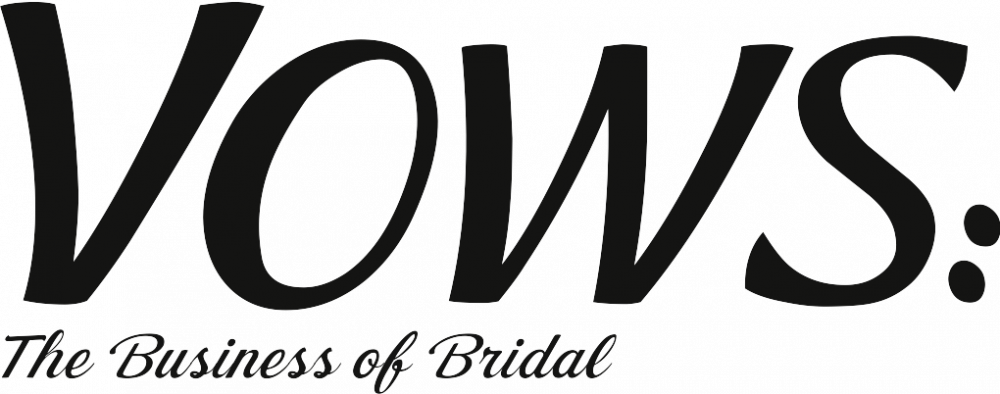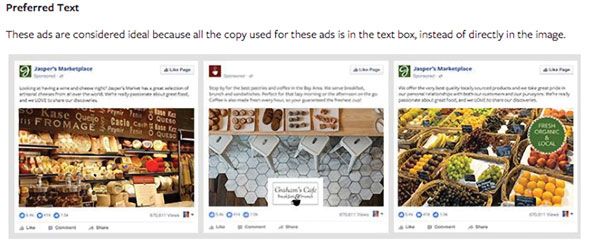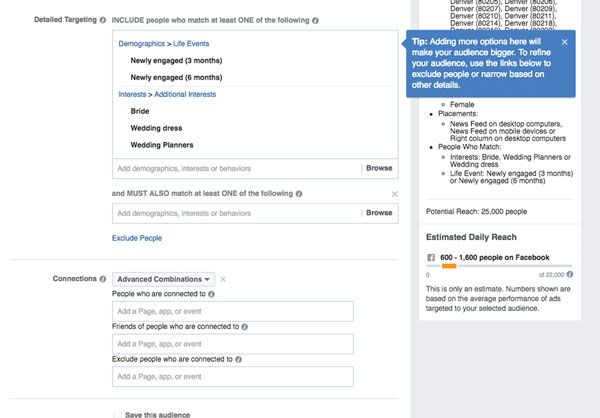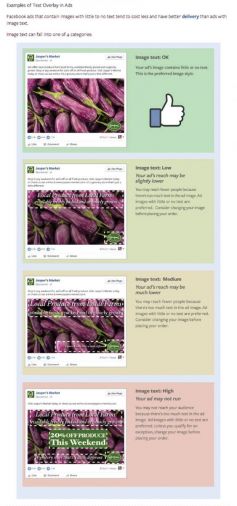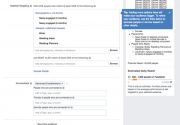If planned or executed poorly, a Facebook advertising campaign can be frustrating and fruitless; but if done right, it can be well worth the time and money spent.
More than two million businesses advertise on Facebook – and for good reason, it seems. The social-media network’s massive audience and its ability to hyper-target very specific groups of users make it one of the best advertising options out there – particularly for specialty retailers such as bridal salons.
Although other social-media networks are beginning to woo much of the younger generation away from Facebook, people between the ages of 25 and 34 – a key demographic in bridal – continue to outnumber any other age bracket of Facebook users, according to eMarketer. In other words, brides are still there.
And being able to selectively share your message with your ideal customers is one of the biggest draws for advertisers.
“Facebook’s targeting options are phenomenal,” says Stephanie Padovani, a wedding business coach with Book More Brides. “You can very specifically target the group you’re trying to reach, and it’s very difficult to do that in a lot of other advertising mediums. So it means you’re getting a better investment and more targeted marketing for your advertising dollars.”
As well, Facebook offers an almost dizzying array of options when it comes to designing an ad. The best choice depends on your objective. The list of possibilities is long, and Facebook adds new features often. Here are a few of the more popular ad options.
Boosted posts: Facebook only shows your posts to 2 to 6 percent of your fans organically, says Adrienne Richardson, a Facebook lead generation expert. If you want more people to see your post, you have to pay to “boost” it.
This is the most basic type of advertising on Facebook and a good way to test the waters. Well-written blog posts and beautiful photos can be good posts to boost. Keep in mind, however, this type of ad is limited in its targeting options and results.
“Boosting a post is a really good way for more of your followers to see what you posted and to get engagement,” Richardson says. “But if you want any other kind of more serious action to be taken, you’re going to want to run a different type of ad.”
Image ads: Most commonly seen in the newsfeed featuring an image(s) and a few lines of text, this type of ad can be used to increase awareness of your store, drive traffic to your website, invite more people to “like” your page, promote an in-store offer or event, and more.
Video ads: Video ads are really popular on Facebook right now. An informative, entertaining or inspiring video featuring your new line of gowns or the latest trends can successfully attract attention to your bridal store. Video ads are typically good at garnering “likes,” comments and shares, but have proven less effective at generating leads and business.
Whatever type of ad you choose, social-media advertising pros suggest the following best-practice guidelines for a successful Facebook ad campaign.
1. Define a specific audience.
Facebook’s capability to deliver an ad to a custom audience is one of its main advantages, yet many advertisers fail to capitalize on this.
“Poor targeting is the biggest mistake people make,” Padovani says. “They’re not really targeting very well, and then they wonder why their ads don’t work.”
Think about who you want to reach, and be specific. Facebook allows you to set parameters based on location, age, gender, relationship status and interests. In bridal, you will likely want to start by targeting engaged women within a certain radius of your store, then fine-tune your audience based on how recently engaged they are or specific Facebook pages they follow such as Brides Magazine or The Knot.
2. Re-target your Facebook fans and website visitors.
The magic of Facebook advertising comes from delivering ads to people who have already shown an interest in your store. Think Facebook fans, brides on your mailing list and website visitors. You can select to include your fans or upload a customer list when creating an ad within Facebook.
The most powerful step you can take in terms of targeting is to add the “Facebook pixel” to your website, according to Padovani. This piece of JavaScript code tracks who visits your website so you can target them with ads later. You’ve probably seen this technique in action. You check out a cute handbag online and the next day you see it advertised on Facebook.
3. Inform and inspire, then sell.
Just as you do on your Facebook page, experts say you should build your Facebook ads in a way that provides value and works to form a relationship before jumping into a sales pitch.
“People are on Facebook because they want to engage with friends, so engage with them like a friend – a helpful friend – instead of trying to sell them,” Padovani says.
While people who are already familiar with you may be ready for special offers and sales promotions, cold traffic needs ads designed to inform, educate or inspire. If you’re not sure what topic to tackle in an informational ad, ask your customers what would be of interest to them.
4. Fit in on Facebook.
People use Facebook to see what their friends and family are up to, read interesting articles and get recommendations from people they already trust, says Kathleen Cutler, a digital marketing strategist.
“You don’t want to disrupt their experience; we want to enhance it,” Cutler says.
She recommends being as “native” to what is already on Facebook as you possibly can. In other words, make your ad look like it belongs in someone’s newsfeed. Incorporating customer-sourced content such as reviews, quotes, stories and photos into your ad can be an especially effective way to make it feel more authentic and create a more relatable experience.
5. Use eye-catching images.
Images are the first thing people will notice about your ad, so choose something that catches the eye and represents your brand well.
“You really want to use images that are going to stop people in their tracks, and that means stop them from scrolling through the newsfeed,” Richardson says.
Remember your photos will be competing with pictures of your customers’ friends and family.
The good news is bridal lends itself to stunning photography, and you probably have photos of beautiful brides in amazing gowns at your fingertips. And again, high-quality photos of real brides are preferable to stock photos. Pictures of people looking at the camera do well, too, Cutler adds.
Pros suggest photos with bright colors to stand out against Facebook’s white and blue color scheme. If you’re using a photo that’s mostly white, add a bright border to help it pop.
6. Craft clear and conversational copy.
People like to do business with people, Richardson says, so write your ad copy in a friendly and conversational, yet professional, style. Be yourself and use a voice that is consistent with your brand. Use simple and punchy sentences, and keep it short, sweet and to the point.
“I know people like to get really clever, and sometimes it works,” Richardson says. “But if it’s not clear what you’re talking about, then clever is going to kill your ad. Clear and concise is better than cute and clever.”
Read your copy out loud to see if it flows. Make sure it answers the questions who, what, when, where and why – details that may seem obvious to you, but not to your prospective customer. And don’t forget spellcheck!
7. Include a compelling call to action.
If you want people to take a certain action after seeing your ad, tell them what to do. Use a short, clear call to action such as “Visit our salon” or “Find your dream dress.” Facebook also lets you add a call-to-action “button” to ads. Options may include Shop Now, Learn More, Sign Up, Book Now and Download.
In addition, if linking to your website, make sure the call to action aligns with the landing page. For example, if you invite a bride to learn more about a trunk show, link directly to the event details page on your website. Too often, rookie advertisers send Facebook ad traffic to their homepage, Padovani says, which can frustrate customers and hurt conversion rates.
8. Track results online and in-store.
As with any marketing campaign, it’s important to track and monitor the results of your Facebook advertising in order to know which ads are working well and which need fine-tuning.
Facebook’s Ads Manager feature displays each ad’s results, reach, frequency, cost and other details. As well, conversions can be broken down by age, gender and other demographics to see who is responding to your ad.
Keep an eye on these numbers, but don’t lose sight of the big picture. Ultimately, you want your Facebook ads to translate into brides making a purchase in your store. To accurately gauge return on investment, be sure to also measure offline response by having a system in place in-store to track how customers heard of your business.
9. Take things one step at a time.
When venturing into the world of Facebook advertising, go at your own pace. Perhaps start by boosting a post to get a sense of what types of content your audience responds to. Then, become familiar with Facebook’s targeting options, and create one informational ad to reach new customers and one promotional piece for your Facebook fans and website visitors.
Once an ad is up and running, Padovani advises leaving it alone for at least five days to give the Facebook algorithm time to fully optimize the ad. Then, you can evaluate the response and make changes as needed.
“And once you have an ad that works, just keep running that baby until it stops giving you the results you’re looking for,” Richardson says.
10. Adhere to Facebook advertising policies.
Before your ad can be seen online, it will need Facebook’s stamp of approval. Facebook reviews all ads to ensure they meet the site’s advertising policies, which you can review at https://www.facebook.com/policies/ads/.
Heads up! Among the potential pitfalls that commonly result in disapproved ads is a rule concerning text overlays. Ads cannot include images with text that covers more than 20 percent of the image’s area.
Lastly, while the information shared here is good advice for the time being, social media evolves rapidly. Keep informed of any changes affecting advertising policies and options in order to avoid missteps and to make good use of all that Facebook rolls out down the road.
Advertising Prom on Facebook?
Social-media advertising best practices relating to targeting a specific audience and creating ads that effectively communicate your message apply whether you are promoting bridal or any other product line. But when investing in paid Facebook advertising to promote prom specifically, there are a few additional factors to consider.
First, find out what social-media sites your prom customers are using. Facebook’s popularity is waning with teens, so you might find that your target market is better reached via sites like Snapchat, Tumbler or Instagram.
That being said, there are still plenty of teens on Facebook, so including the social-media network in your prom advertising campaign is at least worth testing. Go for bright, beautiful pictures of young people dressed for prom and having a blast. Or promote a blog post sharing this season’s celebrity-inspired styles.
Social-media advertising pros suggest putting together a separate Facebook ad targeting parents of prom-age kids. They’re more active on Facebook and most likely footing the bill for their teen’s prom attire. Consider what kind of ad messaging most resonates with your prom moms, whether they’re drawn to sales and promotions, or are moved by emotional – or even nostalgic – appeals.

